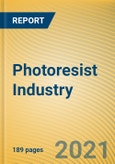Since its invention in 1959, photoresist has been the most crucial process material for the semiconductor industry. Photoresist was improved as a key material used in the manufacturing process of printed circuit boards (PCB). In the 1990s, photoresist was used for processing and producing LCD devices, playing an important role in production of large-size, highly refined and color LCD panels.
In 2020, global photoresist market was valued at USD8.7 billion, sustaining CAGR of 4.6% or so since 2010, and it will outnumber USD12 billion in 2026 with advances in electronic technologies in automobile, AI, national defense, among others in the forthcoming years, showing CAGR of up to 5.5% between 2020 and 2026. China’s photoresist market has grown at a faster rate than the global average since 2011, thanks to the transferring of semiconductor, display panel and PCB industries to the East. In 2020, the photoresist sales in China reached around RMB8.74 billion, or virtually 14.6% of the global total, leaving enormous room for growth. It is conceivable that the Chinese photoresist market is ever enlarging amid migration of display panel and advanced semiconductor production to China, expectedly to RMB15.64 billion in 2026, with the CARG up to 7.2% during 2020-2026.
By application, photoresists fall into PCB, FPD, semiconductor and other types. In 2020, in global photoresist market, PCB, FPD and semiconductor segments were worth USD2.05 billion, USD2.25 billion and USD2.04 billion, sharing 23.6%, 25.9% and 23.3% of the global total, separately. In China, PCB photoresist prevails in market, sweeping a stargering 91.7%, while those for flat panel display and semiconductor take a tiny share. Yet the FPD capacity expansion and rapider localization of wafer fabrication will push up the two segments’ demand for photoresists.
Global photoresist market is long monopolized by Japanese and American companies, with the top five players alone commanding a whopping 87% of the highly concentrated market. Four Japanese companies, JSR, Tokyo Ohka Kogyo, Shin-Etsu Chemical and Fujifilm Electronic Materials, take a combined 72.5% share. And the core technologies for high resolution KrF/ArF semiconductor photoresists are blockaded by companies from Japan and the US, and the more advanced EUV photoresist market is totally ruled by Japanese players. Through the lens of the market pattern, Japan is home to photoresist giants.
Chinese companies including Shenzhen Rongda Photosensitive & Technology Co., Ltd., New East New Materials Co., Ltd., Beijing Lituoda Sci-Technology Co., Ltd., Shanghai Phichem Material Co., Ltd. and Suzhou Crystal Clear Chemical Co., Ltd., win a place in PCB wet film, LCD photoresist, and LED wide g/i/h line fields; Jiangsu Yoke Technology Co., Ltd. makes a foray into CF black photoresist market by acquiring part of LG Chem’s color photoresist assets. In the semiconductor photoresist field, Chinese producers focus on low-end product lines (g/I line and cyclized rubber photoresist). In December 2020, the ArF photoresist independently developed by Jiangsu Nata Opto-electronic Material Co., Ltd. passed the use certification of Wuhan Xinxin Semiconductor Manufacturing Co., Ltd. (XMC), the first homemade ArF photoresist passing the product verification in China. Meanwhile, Nata Opto-electronic raised RMB150 million for its photoresist projects, including development and commercialization projects of advanced photoresist and high-purity supporting materials and ArF photoresist products.
Global and China Photoresist Industry Report, 2021-2026 highlights the following:
- Photoresist industry (definition and classification, industry chain, technology trends, etc.);
- Global photoresist market and markets in major countries (size, structure, regional pattern, import & export, etc.);
- China photoresist industry (market size, competitive pattern, import & export, etc.);
- Global and China photoresist market segments (semiconductor, PCB, LCD, etc.) (size, competitive pattern, etc.);
- 13 global and 11 Chinese photoresist producers (operation, photoresist products and business, key projects, forecast, etc.).
This product will be delivered within 3-5 business days.
Table of Contents
Companies Mentioned
- Tokyo Ohka Kogyo
- JSR
- Shin-EtsuChemical
- DuPont
- FUJI film
- Sumitomo Chemical
- Merck
- Eternal Materials
- DongjinSemichem
- Kumho Petrochemical
- Everlight Chemical
- AsahiKasei
- Chimei
- Changzhou Tronly New Electronic Materials Co., Ltd.
- Zhejiang Yongtai Technology Co., Ltd.
- Shanghai PhiChem Material Co., Ltd.
- Kempur Microelectronics Inc.
- Suzhou Crystal Clear Chemical Co., Ltd (SCCC)
- Suzhou Ruihong Electronic Chemical Co., Ltd.
- Shenzhen RongDa Photosensitive Science & Technology Co., Ltd.
- Jiangsu Nata Opto-electronic Material Co., Ltd.
- Shanghai Sinyang Semiconductor Materials Co., Ltd.
- Weifang Suntific Microelectronic Materials Co., Ltd.
- Beijing Asahi Electronic Materials Co., Ltd.(BAE)
- Xuzhou B&C Chemical Co., Ltd.








